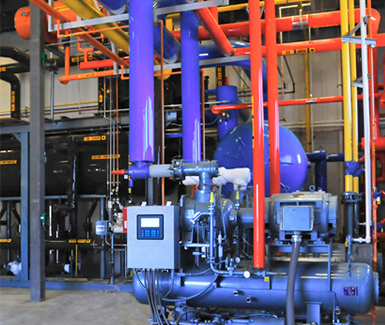When it comes to ammonia refrigeration machine rooms, ventilation updates can often be overlooked.
Current and new mechanical codes — International Mechanical Code (IMC) and Uniform Mechanical Code (UMC) — defer to IIAR 2 (and sometimes ASHRAE 15) as the referenced code for ammonia refrigeration systems, including the machine room ventilation.
Just because your ammonia system was designed to code years ago it may not necessarily be code compliant today.
If you have updated your refrigeration system recently, did you update your machine room’s ventilation as well?
Changes such as machine room expansions or additional heat loads in the room (most commonly from additional motor horsepower) are changes that can often trigger a mandatory machine room ventilation update.
Mechanical and automation: Two vital aspects of ventilation
A machine room’s mechanical ventilation is comprised of two parts:
- Mechanical (air flow)
- Automation (controls)
For the mechanical portion, there are typically three important rates to meet:
- Occupied/normal rate — an airflow rate mandated as a minimum for a machine room
- Temperature control rate — an airflow rate calculated to limit the maximum temperature in a machine room
- Emergency rate — an airflow rate calculated to prevent an ammonia concentration greater than ¼ of the lower flammable limit (concentration of 4% or 40,000 ppm)
While the mechanical aspect is typically what we think of in terms of the system’s operation, automation is just as critical because it ensures the ventilation fans activate to deliver the required flow rates. Typical automation elements for ventilation systems include refrigerant detectors, temperature sensors and manual switches to trigger specific flow rates.
Both the mechanical side and automation side must comply to meet code.
For example, the IIAR 2 – 2014 emergency ventilation set point is 150 ppm. Just because you have the proper fan size, doesn’t mean you’re up to code if it’s not installed correctly and/or if it’s not controlled to meet the adequate ventilation rate.
Signs that your ventilation system may not be code compliant
There are some easy red flags to look for that may indicate your ventilation system isn’t up to code, including:
- Your emergency exhaust fans are down blasting — One of the main requirements of IIAR 2 – 2014 is that emergency exhaust fans must blast upwards at 2500 feet per minute. While you may not be able to measure the blast rate, you can easily see if the fans are pointed up or down. If they’re pointed down, that’s a sign that you have at least one aspect of your system (and likely more) that is not code compliant.
- Emergency controls are located outside of the primary machine room entrance — IIAR 2 – 2014 requires emergency controls outside the primary machine room entrance to shutdown certain equipment and to activate emergency ventilation. If both do not exist at your facility, then you are more than likely not compliant.
- You upgraded your refrigeration system and/or expanded your machine room, but didn’t update the ventilation system — Just because one was done, doesn’t mean the other was. I’ve seen ventilation systems built to 1990s standards with compressors that were added in the 2010s. They don’t line up. In most of these cases, the ventilation system is not code compliant.
- You don’t have a machine room ventilation calculation to support your existing ventilation — For ammonia systems following process safety management (PSM) compliance requirements, having a machine room ventilation calculation on file is a must.
Find out if you’re not up to code (and do something about it)
We often conduct machine room ventilation studies and calculations to analyze a facility’s current setup and determine which elements of the system are up to code and which aren’t.
If you already know your machine room is not compliant, Stellar can provide a package of bid-level drawings and documents so that you can bid the work out to multiple contractors.
If you’re looking for a single-source solution, we can perform a ventilation study, bid the work out, finalize the design and install everything for you. We never reverse-engineer to old codes, but rather seek to bring everything up to the latest standards to reduce risk for owners.
Code violations are not only costly, but neglecting proper ventilation can also create a much bigger problem in the event of an emergency. Don’t cut corners on this important, but often overlooked, aspect of your ammonia refrigeration system.
Want to confirm if your ventilation system is code compliant? Have questions about what to do next? Email me at foodforthought@stellar.net or leave a comment below.




